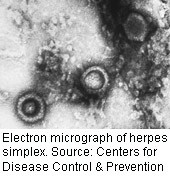- Skip Storing This Everyday Product in the Fridge Door
- Green Tea + B3 Pairing May Boost Brain Health
- Navigating Your Midlife Crisis: Embracing New Possibilities
- City Raccoons Showing Signs of Domestication
- Mapping the Exposome: Science Broadens Focus to Environmental Disease Triggers
- One Week Less on Social Media Linked to Better Mental Health
- Your Brain Changes in Stages as You Age, Study Finds
- Some Suicide Victims Show No Typical Warning Signs, Study Finds
- ByHeart Formula Faces Lawsuits After Babies Sickened With Botulism
- Switch to Vegan Diet Could Cut Your Greenhouse Gas Emissions in Half
Cold Sore Virus Active Without Symptoms, Study Finds


The virus that causes cold sores — herpes simplex type 1 — remains active even in the absence of symptoms, according to a new study.
Researchers in Australia found there’s an ongoing struggle in the cells of people infected with the virus. This explains why some people with the virus never develop cold sores and why others get them only occasionally. The authors said the findings could lead to the development of new treatments.
“We thought when the disease was dormant, it was a truce. It turns out that the virus is waking up more often than we thought, but our cells are constantly pushing it down,” said David Tscharke, associate professor in the Research School of Biology at Australian National University.
“When we thought there was nothing going on we had no targets to look at. Now [that] we know there is an interaction, we can look for ways to help the good guys to win,” Tscharke said in a university news release.
In conducting the study, published July 24 in PLOS Pathogens, the researchers used cells and viruses that were genetically modified so infected cells turned bright yellow even when the virus was inactive. This allowed the infected cells to be identified. Then, using a microscope equipped with a laser, the scientists measured levels of viral activity in the cells.
“We expected that we would see no activity in the dormant cells,” Tscharke said. “The surprise came when we found the virus was doing something in many cells.”
Cells also have different levels of viral activity, the researchers found. “For some it’s very low and in others more of the virus genes are turned on. The host cells were responding most strongly when there was lots of virus activity,” Tscharke said.
More information
The American Academy of Dermatology has more about herpes simplex.
Source: HealthDay
Copyright © 2025 HealthDay. All rights reserved.










